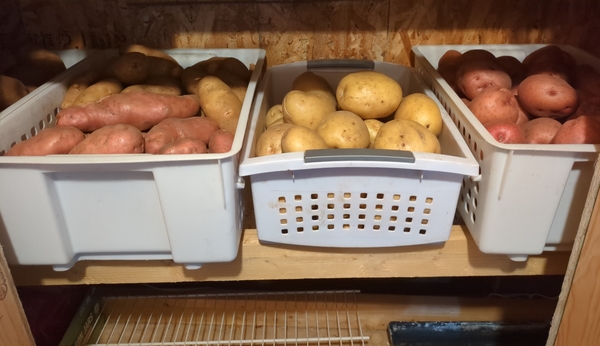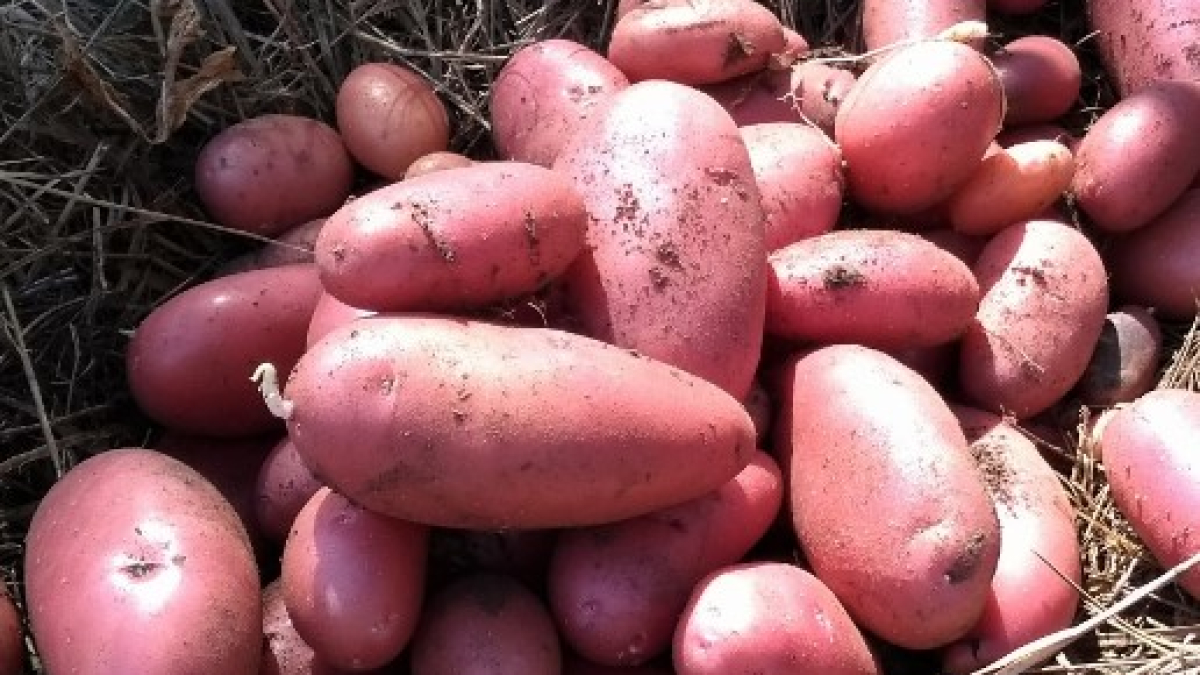POTATOES

If you like potatoes, you’ve come to the right place at high elevation! Potatoes are one of the things that grow very well here. They like our cooler days & nights, and our shorter seasons are still plenty long enough for potatoes. We’ve often heard stories of homesteaders who came to the mountains of Colorado and grew potatoes. I used to wonder about that, since so much of the soil is rocky, but they must have gotten their draft horses and ploughs to till the soil and removed the rocks by hand. I’m glad we have those raised beds!
One caveat: As I say all over the place in this website, “Every Year Is Different.” Most years I harvest plenty of potatoes, but occasionally the harvest is a bit disappointing. I just shrug my shoulders and think “that’s life in the mountains.”

This photo shows the potato plants growing and overflowing their beds. They were so tall and sprawled out the sides, I eventually pruned the plants back, hoping they’d put more energy into the potatoes, rather than the plants.
HIGH ELEVATION GROWING TIPS:
POTATOES
SEED POTATOES: In the earlier years of my garden, I’ve purchased seed potatoes for planting. Now that I know which ones I like and which ones do well in my garden, each fall I select a few that I think will make good seed potatoes; not too large and with plenty of eyes. I’ll save more than I intend to plant, in case some of them don’t do so well in storage. These save quite nicely in my cold closet storage. I set these apart from the potatoes I’ll be eating, just to be sure I don’t forget. About 10 days prior to planting, I’ll take them out of cold storage to “chit” prior to planting.
SOIL PREP: The soil in all my raised beds is very good, after years of keeping it in good condition. Each fall we top the beds with about 2″ compost and let it sit that way all winter. In the spring, we till in the compost, and the soil is ready for whatever will be planted. For the compost-ready potato beds, each year I mix in soil acidifier (12 lbs per 100 sq.ft.), bone meal (10 lbs per 100 sq.ft.), and a sprinkling of wood ash sometime within a week or so prior to planting. Weather permitting, potatoes are generally planted May 15, about a month prior to our average last frost date.
My raised garden beds are either 3×12′ or 2.5×8′. The wider beds are planted with 12-14 plants in two rows about 18″ apart. The narrower beds are planted with 5-6 plants in a single row. To plant, I dig trenches for the seed potatoes with the excess soil from those trenches piled along the edges. so I can “hill up” the soil as the potatoes grow. The trenches at that point will be roughly 8-10″ deep.
PLANTING: After the trenches are in place, I’ll place each seed potato about 2″ below the surface at the bottom of the trench with some comfrey leaves, a sprinkling of kelp meal or greensand, and some Espoma Bio-Tone, my favorite starter fertilizer. Potatoes like plenty of potassium, provided by the comfrey & kelp meal/greensand. The potatoes are left in their trenches & watered in. They can be mulched at this time, but I don’t think it’s necessary.
Since the potatoes are underground, some light frosts are acceptable prior to sprouting, however I am always ready to cover potatoes with frost cloth after they sprout if necessary. The tender potato plants are quite susceptible to frost. If they do suffer from a bit of frost, they should come back, you’ll just lose a little growth time.
GROWING: As the potatoes begin to grow taller, the trenches should gradually be filled in with soil until eventually the surface is even. As I fill the trenches, I’ll add another sprinkling of kelp meal or greensand along with more comfrey leaves. As potatoes continue to grow, I add more mulch, being sure that any potatoes growing near the surface are covered to prevent them from turning green due to exposure to the sun. If there is more good soil available to add to the top, hilling up more soil is helpful for potato growth, however in my raised beds I just don’t have the room to do this.
If flowers appear on the plants, I generally snip them off to encourage more growth to the potatoes underground. Some years I have pruned the plants as they get tall & out of control, other years I have left them be–I don’t see any real difference in the amount of potatoes harvested. After the plants turn brown and fall over, usually after the first couple of frosts in September, I’ll trim them back to about 3″ above the ground and be sure they’re mulched well enough to cover any potatoes growing near the surface.
HARVEST: Near the end of August I’ll begin digging up a few potatoes here & there to eat, but the bulk of the potatoes are left in the ground until sometime near the end of October. The longer I can keep them in the ground the longer they will keep in storage, however I want to get them out of the ground before the ground should freeze enough to make digging difficult. Some folks will encourage you to leave the potatoes in the ground under lots of mulch, but in my location it gets too cold–they’ll freeze and turn to mush.
CURING & STORAGE: After harvesting, I’ll leave the potatoes in a somewhat cool, dark, airy location for 10-14 days or so, to toughen up the skins prior to cold storage. After that, I simply store them in my cold closet and eat them up throughout the fall & winter months.
SEED POTATOES: PURCHASED OR SAVED?
Most books and websites highly recommend purchasing seed potatoes each year. I wondered why? Are these people all getting kickbacks from the companies that sell the “certified” seed potatoes? What’s the deal?
I don’t know, but for several years now I have saved my own seed potatoes and they grow just fine.
"EVERY YEAR IS DIFFERENT"
I don’t really know why, but some years my potato harvest is lacking, when compared with other years. Even when planting the same potato varieties & using the same planting methods, I just cannot seem to control how well the potatoes will grow. There must be something about the weather that changes enough from year to year to affect the results.
One year I did try a different method, which resulted in a small harvest…. see below.
DON'T DO THIS!
One year I tried a new method after reading some articles & watching videos that suggested good success and easier harvesting. Instead of digging trenches in the beds, I laid the seed potatoes on the top of the soil and mulched very well over the top, increasing the depth of the mulch as the potatoes grew.
These potato PLANTS grew abundantly. They were tall & full and falling over early on. However, the POTATOES were somewhat small in size as well as in quantity. Other than that, they were very good, without blemishes. Unfortunately, I planted ALL the potatoes with this method that year, without leaving at least one section done the way I usually do. I don’t know if the small number & size was due to the varieties I’d chosen, the climate that year, or the method, but I highly suspect it was due to the method.
The following year I grew some of these same varieties from the potatoes I’d saved, and using the old trench method they did very well.
POTATO HARVESTING & STORAGE
We leave our potatoes in the ground as long as possible, so the ground will keep them fresh & cold. This allows us to store them as long as possible.
We dig up the potatoes in late October or early November, cure them in a dark place, unwashed, at about 60°F for a couple of weeks, then we place them in bins into our Cold Closet for long-term storage. The cold closet ranges is normally around 36-40°F throughout the winter, with a pan of water inside to add humidity. The potatoes will keep nicely there until the following spring, and are also in good enough shape to use as seed potatoes in May.

POTATO VARIETiES GROWN
Currently I grow the following every year.
Burbank (Russet) | 100+ Days | Very nice, many large sized russet.
Caribou (Russet) | 80-90 Days | Nice russet.
Red Pontiac (Red) | 80+ Days | Huge harvest, good keeper.
Desiree (Red) | 80+ Days | Very good and abundant!
Yukon Gold (Yellow) | 65+ Days | Huge, smooth & creamy.
I have grown these in past years.
Chieftain (Red) | 65-80 Days | Nice red potato.
Yukon Blush (Pink) | 65+ Days | Not a big harvest that year.
Purple Majesty (Purple) | 80+ Days | Most were small, but nice.
French Fingerling (Red) | 80+ Days | Abundant harvest.
Norkotah (Russet) | 80+ Days | Nice russet.
Pioneer (Russet) | 80+ Days | Inconsistent, some cracking.
- Laurie
- Revised November 2025

